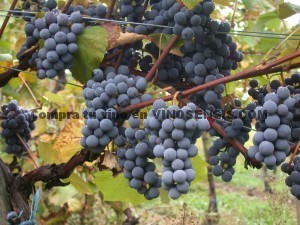
por Vinosensis | Jun 18, 2010 | Grapes
Introduction Throughout the Spanish territory exist hundreds of varieties of grapes, each with a specific name. Some are notable for their tastes or their ability to enrich a wine with sugar or alcohol when mixed with other grapes. The grape “Cokon de gato” (Cat’s testicles!) is one of those grapes that has never had much fame because of their unusual characteristics compared with other more “noble” grapes such as Tempranillo or Cabernet Sauvignon. But, due to its very original name, some grape growers decided to mix it with more traditional grapes and use its name as an marketing argument – and it worked very well. Wine lovers have humour… Origins “Cat’s balls” is a grape variety traditionally cultivated in Somontano, particularly in the Secastilla area; however there is some in La Mancha, Aragon and elsewhere in very limited volumes. It has never been among the most valued and, in fact, it was used to give consistency to certain wines, as it is strong and even harsh. It has a very elongated grain, so some believe its name comes from that particular shape. Where is it grown? Given its “poor” characteristics it is more appropriate as a table grape cultivation and remains very limited in the regions of Somontano and La Mancha. Aromas There are, for now, no varietal wine made from the “Cat’s balls” grape so their aromas and essences are still poorly documented. Moreover, the few wines that incorporate the grapes in their wines are made by mixing it with other grapes such as Shyra and Merlot. In fact, the grape is used for the sole purpose of giving the wine a name that stands out... por Vinosensis | Jun 11, 2010 | Grapes
Introduction to Albariño If there is a Galician grape variety par excellence, this should be the Albariño. This white grape has many followers in the world, as its floral aromas and flavors of peach with some spicy notes have become a true delicacy for all lovers of white wines. Origins According to information from Wikipedia about the Albariño grape: “There are theories that indicate that the monks of Cluny brought the grape to Armenteira monastery (in the Pontevedra region of ‘O Salnés’) in the twelfth century. From there its cultivation spread to the rest of Galicia and northern Portugal. Umia River is considered the father of Albariño in its banks as the vine is grown and produced this wine from the Middle Ages.Today this theory is regarded as a mere legend, and the Albariño is a variety native of Galicia.” “(Http://es.wikipedia.org/wiki/Albariño) Where is Albariño grown? The best wines made from Albariño grape are in Galicia, more precisely in the Rias Baixas Designation of Origin, established in 1988. The districts of Condado Rosal and Salnés are those with the highest concentration of this luxurious and aromatic white grapes. In Galicia, it is also cultivated in the Denominations of Origin “Ribeiro”, “Ribeira Sacra.” Also, since 2007 you can find some wine with Albariño protected by the mention of the Tierra de Barbanza and Iria, which comprises most of the municipalities bordering the Ria de Arosa. Albariño wines can also be found in producers from Portugal. In Portugal, the wines made from Albariño are called vinho verde. Apart from Galicia and Portugal, Albariño vines can be found in Cantabria, Castilla y Leon and Catalonia. Its presence in the United States is very... 
por Vinosensis | May 27, 2010 | Grapes
Introduction The name Tempranillo comes from the diminutive of Temprano (Early in Spanish), and refers to the fact that the grapes ripen several weeks earlier than many other varieties found on the Spanish territory. This variety is considered by many as the noble grape of Spain. Origins For many years it was believed that the Tempranillo grape was related to Pinot Noir. But recent studies of its genetic code have proven that Tempranillo is an independent grape, having no relationship with Pinot Noir. Where does it grow? Tempranillo is the king of grapes in Spain and is located in almost the whole of the Iberian Peninsula, under various names like Ull de Llebre in Catalonia or Tinto del Pais. The two most important regions of Spain for Tempranillo are Rioja, in north-central Spain and the Ribera del Duero, located a little further south-west. Tempranillo is the main grape of Rioja, where a typical mixture contains 90-100% and is also present in wines from Ribera del Duero. Significant quantities are also grown in the regions of Penedès, Navarra and Valdepeñas. In addition, you can find it in almost every denomination of Spanish origin, such as: Almansa, Calatayud (4%), Campo de Borja (11%), Carignan (15%) Cigales Conca de Barberà Costers del Segre, Jumilla, La Mancha, Méntrida, Navarra (15%), Penedes, Rioja, Ribera del Duero, Somontano Valdepeñas (13%) and de Vinos de Madrid (5%). In the early 20th century (1905), Frederick Bioletti brought the Tempranillo grape to California (USA) where its adoption by local producers has been complicated by the characteristics of the grapes, which do not grow well under conditions of hot and dry climate. Later, during the 1980s,... 


